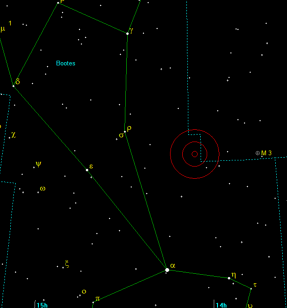
NGC 5466 – Globular Cluster in Boötes
RA 14h05m27.3s Dec +28deg 32’04”
Size 9.0’ Vmag 9.2
As we head toward the summer months and begin looking back toward the halo of the galaxy, our skies become filled with many visual observers’ favorite class of objects: the globular clusters. The summer skies contain several interesting and very bright globulars, like M3 and M5 with their nice bright cores, or M4 with its easy resolvability and unique “bar” of stars in the center. This month’s challenge target on the other hand does not look like those clusters.
NGC 5466 was discovered on May 17, 1784 by William Herschel. It is a very loose globular cluster, ranking class XII (out of XII) on the Shapley-Sawyer concentration class scale. The individual stars in the cluster are rather faint, with the brightest of them around the 14th magnitude. The combination of that fact plus the low concentration leads to a considerably low surface brightness, and therefore a considerable vulnerability to light pollution. I first observed NGC 5466 on my very first night using my 16” Dob back in 2014. My log entry is as follows:
8/23/2014 10:15 PM – 16” f/4.5 Dobsonian 46x-203x
Very difficult object. Faint, fuzzy cloud. Requires averted vision. Cannot resolve into stars at 46x. At 203x, now resolved very easily into stars at the limit of my scope's visibility.; Class XII
A year ago when I was one of the 15 or so souls that headed out to the Prude Ranch during TSP week (no one else was going to be there, so easy to social distance), I made a point of reobserving NGC 5466 in the 16”, and logged the following:
5/20/2020 10:28 PM – 16” f/4.5 Dobsonian 61x
Incredible how much easier this one is here versus Columbus; clearly visible with direct vision; even resolving somewhat; very loose globular, Class XII
My observing skills have improved somewhat since my original observation as well, so I would not suspect today that NGC 5466 is quite as difficult as I made it sound, but nonetheless the striking difference with my observation from West Texas indicates just how much even a slightly brighter sky can have an effect on low surface brightness objects. NGC 5466 is in a relatively blank area of sky between the constellation Boötes and M3. The best way to find it is probably just to triangulate its location with ρ and ε Boötis (see first chart below) and then zero in on its precise location looking for the stars near it as shown in the second chart below. In smaller telescopes it will probably require averted vision to see at all, so noting the field stars is definitely important.

The HAS VSIG would love to hear about your own visual observations of NGC 5466. Send them to the VSIG list server. To get on the VSIG email list server, contact me at stephenj@astronomyhouston.org.


